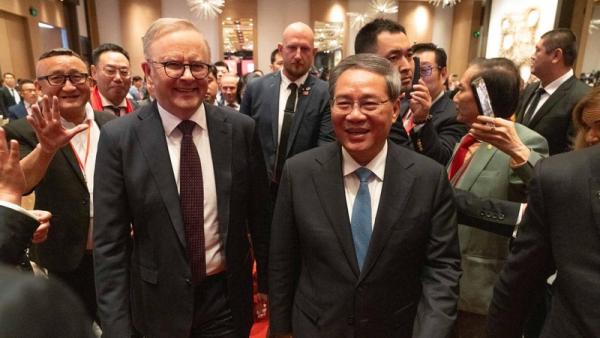Are China–Australia relations ‘back on track’ after Li’s visit?
@AlboMP / X

Elena Collinson, Manager, Research Analysis, Australia-China Relations Institute, University of Technology Sydney |
This article appeared in The Saturday Paper on June 22 2024.
The Chinese premier’s four-day visit to Australia showed both countries’ leaders endeavouring to walk out of the shadows of earlier tensions – but their memory lingers uncomfortably in the public and policy debate.
The protesters assembled on the lawns outside Parliament House demonstrated the pressure on Prime Minister Anthony Albanese to raise Australia’s human rights and security concerns with Premier Li Qiang. This was most evident during Monday’s press conference, where Chinese officials attempted to block from the view of the cameras journalist Cheng Lei, who was recently released after three years’ detention in Beijing. The premier’s visit also coincided with another dangerous escalation in tensions between Chinese and Philippine vessels in the South China Sea, where a Filipino sailor was seriously injured following a collision.
The planned aspects of the premier’s visit were a study in neutrality. The itinerary for this first tour by an official of his seniority since 2017 was primarily focused on building political dialogue and cultivating business ties.
Adelaide was his first stop upon arriving in Australia on June 15, where the emphasis was on gestures of goodwill. Aside from the offer of two new pandas for the local zoo, officials highlighted the re-entry of Australian wine into the Chinese market after more than three years of sector-stunting tariffs by Beijing. Li then travelled to Canberra for the Annual Leaders’ Meeting with Prime Minister Anthony Albanese and a state lunch with community and business leaders, before concluding his trip in Perth on June 18 with a tour of a Chinese majority-owned lithium processing plant.
As for the concrete steps, the Australian prime minister and Chinese premier signed a series of agreements on trade, climate action, education/research and cultural exchange, areas that had been nominated for further bilateral cooperation during Albanese’s November visit to China.
Fifteen-day visa waivers were announced for Australian travellers, and a ‘step up’ in dialogue about Pacific island development was pledged. The two leaders also undertook to look into the establishment of a new protocol on military-to-military communication.
While Albanese and Li respectively described the relationship as ‘renewed and revitalised’ and ‘back on track’, Canberra and Beijing are continuing to feel out what an optimal settling point might look like, what the relationship’s parameters are and how to work within them. Albanese was careful to say ‘there is no fixed model for a stabilised relationship’. Li’s visit shows that, at best, this notion of ‘stability’ remains a work in progress, particularly with respect to how to navigate tensions.
The premier urged the ‘shelving of differences’ and pointed to the need to ‘uphold the right characterisation of our bilateral relationship’, an indication there is, in Beijing’s view, a correct and incorrect way to represent and treat differences.
Albanese countered that in the joint presentation to the press, however, saying, ‘We won’t always agree – and the points on which we disagree won’t simply disappear if we leave them in silence.’ Albanese knows the sotto voce criticism of his China relations management is that too often he bites his tongue when it comes to moments of discomfort.
The Australian stance is indicative, too, of the fundamental tension between the government’s talk of pursuing and attaining stabilised relations with China and its effective acknowledgement that China is a strategic threat, particularly given its expanding influence throughout the Pacific. This is evident in the fact that, in the immediate wake of Li’s visit, Foreign Affairs Minister Penny Wong departed to Papua New Guinea for an annual forum, with a large party of senior government ministers, including the Minister for Defence Richard Marles, the attorney-general and the minister for home affairs.
While Marles told a security conference in Singapore on June 1 that Australia bore ‘no indelible hostility to China’, much of this country’s foreign and defence policies, as well as some aspects of its domestic policy, are driven by the anticipation of possible hostility from China.
Dr Michael Clarke, senior lecturer at Deakin University’s Centre for Future Defence and National Security, says the overall trajectory of Australian defence strategy and policy makes it ‘clear that Canberra sees China, if not as a direct and immediate threat to regional and Australian security, then certainly a potential one’.
‘When combined with the apparent normalisation of Sino–US ‘strategic competition’ as an organising principle for both Washington and Beijing’s foreign and defence policies,’ he says, ‘this contradiction has the potential to become more problematic for the Albanese government.’
The Labor Party has thus far avoided major spillover from this tension during its time in government, and it has not completely precluded engagement. ‘Dialogue’ is now enshrined as the marker of progress in relations, alongside the removal of China’s punitive tariffs.
While Penny Wong has stressed the Howard-era no-choice balance between the United States alliance and economic engagement with China is a thing of the past, Clarke observes that the Australian government ‘has made a commitment to ‘rebalance’ the China–Australia and Australia–US elements of its diplomacy and foreign policy’ in a manner that recalls the Howard mantra.
Clarke adds ‘the core problem’ for the government is that ‘the conditions that arguably made Howard’s balancing act possible – notably uncontested US primacy in the Asia–Pacific and Chinese moderation of its ambitions – no longer hold’.
‘Australia is now faced with a regional environment in which most of the most pressing geopolitical, security and economic issues are increasingly framed by Beijing and Washington in a competitive, almost zero-sum way, which will leave diminishing space for middle and smaller powers to manoeuvre,’ Clarke says.
The tour of the Tianqi Lithium Energy Australia plant on the final day of Li’s visit was a symbolic attempt to ease burgeoning tensions related to national security, at least as they apply in the critical-minerals sector. It also highlighted the competing objectives of protecting Australia’s national security and interests, while attracting much-needed investment in its abundant resources for the green transition. While in Perth, Li attended a round table hosted by the Business Council of Australia alongside senior executives from the likes of Rio Tinto, Woodside, Fortescue and BHP.
This month Treasurer Jim Chalmers told five companies with ties to China to divest their holdings in rare earths miner Northern Minerals, and last week Penny Wong said in an ABC interview ‘there will be areas where we’ll pay particular attention to national interest considerations. Critical minerals is one of them.’
Australia China Business Council president David Olsson says Li’s tour of the plant reflected a recognition on both sides of the need ‘to comfortably manage the security/sovereignty issue against the economic need to engage in supply chains’.
He says the business community’s expectations, though ‘tempered’ in the lead-up to the trip, ‘were well and truly well delivered’ at its conclusion. The interactions were ‘very positive and much more forward-looking than we had anticipated’.
The Australia–China business relationship is ‘not going back to where we were before’, Olsson says, referring to pre-2020 levels of engagement, but the scene set by the premier’s visit ‘allows us to explore our ambitions for the next step in the bilateral relationship’, particularly around cooperation on climate and agribusiness.
He also notes that with respect to China, the Australian government and business community ‘are working well together. The government has set the terms and the tone of the relationship. Business is taking its cues from that’.
For his part, Opposition Leader Peter Dutton, who as defence minister in the Morrison government amplified talk of war with China, said he’d ‘love to see the trading relationship increase twofold’, describing increased bilateral trade as ‘a very important part of the manifesto that we’ll take to the next election’. Dutton has probably not undergone a Damascene conversion on China, but he knows his party suffered in key seats at the last election where Chinese–Australians drifted from the Coalition. Nevertheless, his comments on trade only underline the consensus at the heart of the Australian political community on the deep economic complementarity that continues to sustain the relationship.
In his 2022 book Australia’s China Odyssey, Sydney University historian James Curran noted that in the wake of the reconciliatory visit by then Chinese premier Li Keqiang in 2009, following a period of divergence in the relationship, some in the Australian debate remained unconvinced that any kind of lasting floor had been put under the bilateral relationship. Andrew Shearer, now Australia’s top intelligence official, wrote an analysis at the time noting the two countries had moved on, but stressing ‘the underlying issues are structural and have not been resolved’.
In a necessary departure from last week’s carefully choreographed proceedings, Albanese raised Cheng Lei’s mistreatment directly with Li on his final day in Australia, telling the Chinese premier it was ‘unacceptable’. Twenty minutes after Li’s departure, the Department of Foreign Affairs and Trade released a statement expressing the Australian government’s grave concern about the South China Sea incident.
Only time will tell whether this latest visit by a senior Chinese official is a harbinger of a genuine change in the relationship’s dynamic, or merely a holding pattern as the fundamentals of strategic competition take shape.
Author
Elena Collinson is head of analysis at the Australia-China Relations Institute, University of Technology Sydney.

